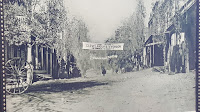A few months ago we relocated (once again) from the Seattle area to Central Pennsylvania to be close to certain archives (Getting ready for the next project) as well as historic sites from colonial times to the Civil War. In short, we moved for history. But that doesn’t mean that the Puget Sound region doesn’t have its share of historic sites. I’m surprised at how many people I meet say that they want to visit Seattle. So I thought I’d share a few of my favorite historic sites around Western Washington.
Ballard Locks/Carl English Garden
The Ballard Locks
What the locals call the Ballard Locks (for the community
it’s located in), is officially named the Hiram Chittenden Locks and is run by the
Army Corp of Engineers. The Ballard Locks connect freshwater Lake Union and
Lake Washington with saltwater Puget Sound. Opened in 1917, it still operates today
providing a water route out of Seattle’s eastside communities to the Pacific
Ocean. Stop by the small museum and gift shop, take a ranger-led tour, or just
hang out and watch the boats go through the Locks (surprisingly relaxing). The
Locks are also the home of the Carl English Botanical Garden with walking paths
through thousands of flowers, shrubs, and trees curated by Corps of Engineers
gardeners.
If you’d like to walk through a temperate rainforest
without leaving the city, take a trip over to Discovery Park. The park is
actually on a large hill overlooking the Ballard Locks and used to be the U.S. Army’s Fort Lawton. Lawton was a point of embarkation during WWII and Korea. You get
some great views of Puget Sound from different points in the park. There are
miles of trails. You can hike down to take an iconic picture of the West Point Lighthouse, see some of the old buildings left over from the army days, and
visit the veteran’s cemetery located in the park.
Museum of History and Industry (MOHAI)
The Denny Regrade, where Seattle
leveled out its steepest hills. seattlepi.com
Everyone knows that Seattle is the home of Starbucks,
Boeing, and Microsoft. But the city and surrounding Puget Sound have a rich
history prior to these industry giants. Western Washington started out as a
collection of “resource towns” supporting industries like lumber, mining,
fishing, and shipping. Seattle was the gateway to the Yukon Goldrush. Seattle
became what it is through an entrepreneurial spirit that even changed the
landscape. That is evidenced by major construction projects like the Locks and
ship canal, and especially the Denny Regrade. This fascinating history is told
through the Museum of History and Industry. The MOHAI (pronounced MO-HI by the
locals) is located on the southern tip of Lake Union. Plan on spending the
whole day, especially since you’ll want to walk around the Center for Wooden Boats co-located there.
Goldrush Museum/Pioneer Square
In 1897 gold was discovered on the Klondike River in
Canada’s Yukon Territory. Just coming off of a deep economic depression,
thousands of fortune hunters from the United States, Canada, and all over the
world, flocked to this remote valley in the far north. Seattle competed with
other cities, namely Portland and San Francisco, to become the place to get
your supplies before jumping off into the wilderness. Seattle won. The story is
told in the Klondike Gold Rush Museum, located in the Pioneer Square
neighborhood and part of the Klondike Gold Rush National Park. The museum is
not large but very interesting. It is my favorite historic site in Seattle. Plus
walking around the Pioneer Square section of town will complete your day. Some of the buildings date from the period of the Klondike Goldrush. Choose one of the great restaurants for lunch and enjoy the historic
architecture.
If you are a fan of aerospace then the Museum of Flight,
located on Boeing Field in South Seattle, is the place for you. It’s my
favorite aviation museum, touted to be the largest, independent, not-for-profit
air and space museum in the world. (Okay, I really like the Smithsonian Air and
Space Museum too, but that’s across the country in D.C.) Plan for the whole day
as there is a lot to see here. As they say, “it’s worth the price of
admission.” My favorite is the “Red Barn,” the birthplace of the Boeing
Aircraft Company in 1916.
Just five you say?
Coast Artillery Museum at Fort Worden
No! These are just my five favorite major historic
attractions in the Seattle area. There is so much more history to see in Puget Sound, especially if you want to drive a little. Check out the National Nordic Museum in Ballard, or the Washington State History Museum in downtown Tacoma. Puget Sound has a deep maritime history. Check out the U.S. Naval Undersea Museum in Keyport or the Puget Sound Navy Museum in Bremerton. And
another favorite of mine is Fort Worden State Historical Park in Port Townsend on the Olympic Peninsula. It's the home of a Coast Artillery Museum and you can explore the concrete batteries where they filmed "An Officer and a Gentleman." It’s a long list. Got one to add? Share it in the comments below.








